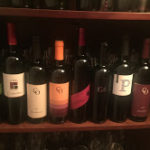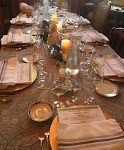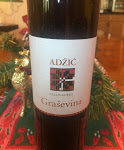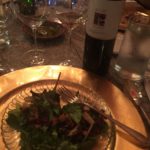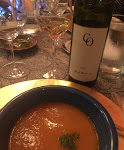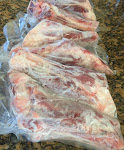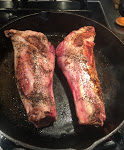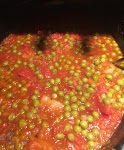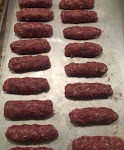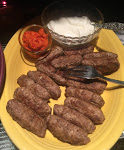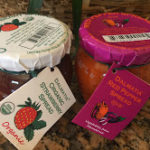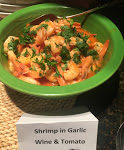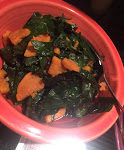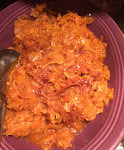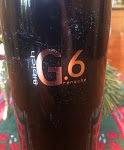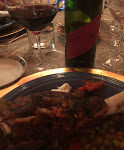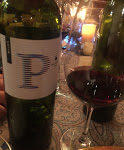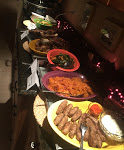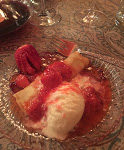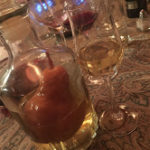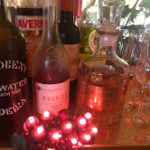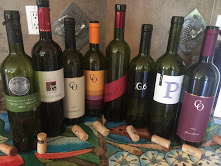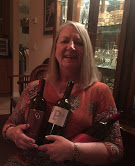What is the most unique wine dinner or tasting that you have ever participated in? That would be hard for me to answer as there have been so many that I consider being truly unique. But this one really earned a place on my center stage! My husband, Chuck, and I recently hosted a Croatian themed wine dinner at our home. Neither one of us has ever been to Croatia nor are we of Croatian heritage; however that did not stop us from sharing our enthusiasm with a few winelover foodie friends who are willing to indulge us! Or should I say “me”! I am the one who dreams up one armchair wine adventure after another. Luckily Chuck is there to support me. In fact one of my winelover foodie friends once said to me that coming to a wine event at our house is like “going to Disneyland”! I took that as a great compliment.
We had never tasted a Croatian wine before. In fact this time last year, I couldn’t even tell you for sure where Croatia is, let alone what grapes are grown there. Now not only can I tell you about a number of the 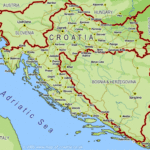 grapes and wines – I can even sketch out a map of Croatia!!!! Talk about keeping up your continuing education after retirement. I can’t think of a better way to keep learning than to study some obscure wine regions and their wines. That has become a passion for me. So here is how the Croatian adventure came to be.
grapes and wines – I can even sketch out a map of Croatia!!!! Talk about keeping up your continuing education after retirement. I can’t think of a better way to keep learning than to study some obscure wine regions and their wines. That has become a passion for me. So here is how the Croatian adventure came to be.
I purchased a most unique book that one of my winelover friends knew I would find interesting – “Cracking Croatian Wine” by Dr.  Matthew Horkey and Charine Tan of “Exotic Wine Travel”. I read the book and knew that I just had to have some of these wines to taste myself. Matthew and Charine are a young couple who became passionate enough about wine that they decided to make wine tasting and traveling in obscure wine regions their full-time mission. Now they provide information about the country, the culture and the food along with the wine in their books, on their website, media pages and their You Tube “Exotic Wine Travel” channel. After all, isn’t that what makes wine so interesting for many of us winelovers? I had already utilized their expertise for the Hungarian portion of our European Volcanic Wine Dinner event and started into their previous book, “Uncorking the Caucasus”.
Matthew Horkey and Charine Tan of “Exotic Wine Travel”. I read the book and knew that I just had to have some of these wines to taste myself. Matthew and Charine are a young couple who became passionate enough about wine that they decided to make wine tasting and traveling in obscure wine regions their full-time mission. Now they provide information about the country, the culture and the food along with the wine in their books, on their website, media pages and their You Tube “Exotic Wine Travel” channel. After all, isn’t that what makes wine so interesting for many of us winelovers? I had already utilized their expertise for the Hungarian portion of our European Volcanic Wine Dinner event and started into their previous book, “Uncorking the Caucasus”.
Why Croatia?
People have been making wine in Croatia for thousands of years. In fact the oldest continuously planted vineyard in the world is in Croatia on the island of Hvar. Europeans have been drinking Croatian wines for centuries, but most of it stayed in Croatia. The history of winemaking began to change there in 1991 when Croatia became an independent nation instead of a state in Yugoslavia. What really brought about change was when our Napa Valley famed winemaker Mike Grgich, who made the winning Chateau Montelena Chardonnay wine for the 1976 Judgment of Paris, began an upscale wine project in his native country of Croatia. This gave Croatian wines a recognizable identity on the international market.
Speaking of the international market, it is still fairly difficult to purchase Croatian wines in the United States. You most likely will not find any at your local big-box stores or even most boutique wine shops. At least I have not seen any. I had discovered a good source for them when purchasing Hungarian wines and that is the Blue Danube Wine Company of Los Altos, CA. Since then I’ve discovered a second source – www.thewineandmore.com – which is Croatia’s leading wine webshop, and it has recently made shipping wines to the US available. I have not used them yet, but it looks like they have a good selection.
Some tips about the grapes
Two-thirds of the wine production in Croatia is white varietals with a grape called Graševina being the most widely planted. Plavic Mali is the leading red and accounts for the other one-third. My available source for wines fairly well dictated what I would be serving to our guests for my Croatian wine adventure; however here are some other grape varietals that may (and should!) be of interest to you.
A few white grapes to know
Debit – is a white wine grape variety grown primarily along the Northern and Central Dalmatian Coast of Croatia. The grapes are medium-sized golden yellow in color and grown in clusters of medium or large size. Wine made from Debit has flavors of citrus, stone fruit and flint.
Graševina– Grahsh-ah-vee-nah – aka Welschriesling – Although it is not related to the true Riesling of Germany, this old grape variety is well suited for the continental climate of Central Europe where it’s extensively cultivated. It is one of the most popular white wine grapes in Croatia. It makes medium-bodied aromatic dry, straw-blond white wine with a flowery aroma, with good roundness and acidity. For the most part Graševina wines are fresh and fruity with flavors of melon, white pear and grass and are best enjoyed in their youth; but the variety can also produce rich dessert wine with lasting bouquet. This was a delightful white wine that paired well with the salad we served at dinner.
Malvasia is a group of grape varieties grown mostly in Croatia, Italy, Slovenia, Corsica, and Spain. It most likely originated in Greece.
Malvazija Istarska (Mal-vahz-ee-yah Ih-star-skah) is THE white wine of Croatian Istria and the north Dalmatian coast. In Slovenian 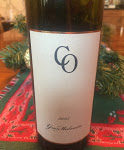 Istria, it is grown in the Koper wine district. Typically, Malvasia Istarska produces deep colored, aromatic, refreshing dry whites with a spice note. They often have aromas of white or yellow flowers and white fruits and may have a slightly bitter end palate. Malvasia Istarska wines can be made in many different styles: fresh and fruity, barrel aged complex and macerated white/orange wines. I loved this wine and can’t wait to try some more!
Istria, it is grown in the Koper wine district. Typically, Malvasia Istarska produces deep colored, aromatic, refreshing dry whites with a spice note. They often have aromas of white or yellow flowers and white fruits and may have a slightly bitter end palate. Malvasia Istarska wines can be made in many different styles: fresh and fruity, barrel aged complex and macerated white/orange wines. I loved this wine and can’t wait to try some more!
Malvasija Dubrovačka – Mal-vahz-ee-yah Duu-broh-vahtchh-kah is different from Malvazija Istarska and grows in Konavle which is near Dubrovnik in South Dalmatia. It tends to have more intense aroma, bigger body and higher acidity than the Istrian variety. It has flavors of stone fruit and yellow flowers. This wine was perfect with an appetizer tray of cheese, cured meats and olives.
Grk – gerk – Grk produces dry white wines with notes of white pepper, melon, herbs, and sliced pear; flavors similar to Chardonnay and Loire Sauvignon Blanc. The variety is indigenous to Croatia and is only found in sandy soils close to Korčula, on an island within the Srednja-Juzna Dalmacija. Grk is highly sought after as only a few producers make wine from Grk.
Pošip– Poh-shhip – Pošip is a native indigenous Dalmatian variety. Some oenologists indicate Pošip’s possible relation to Furmint, the white grape from Hungary that we tasted at our European Volcanic Wine Dinner. It is grown throughout the coast of Dalmatia. Pošip makes full-bodied white wines with subtle almond notes often crisp with flavors of apples, vanilla spice and citrus fruit.
A few red grapes to know
Plavac Mali– Plah-vahts Mah-lee – Plavac Mali is a native grape to Croatia that is grown almost exclusively in the region of Dalmatia. The name literally means “little blue” in Croatian which refers to the small, bluish grapes that the vines grow. This is the primary red grape of Croatia, and it’s rich and full of flavor. The wine is actually a hybrid that descends from Crljenak Kaštelanski and Dobričić and is a cousin to Vranac. The former wine is the Croatian version of what is known as Primitivo in Italy and Zinfandel in California. The flavors change a great deal depending on which of the main mainland areas or islands that the grapes are grown. Overall, it tends to make bold wines with deep flavors of blackberries, dark cherries, pepper, dry figs and other 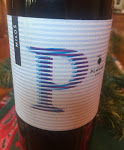 spices. The alcohol can run as high as 15%, but tends to be around 12.5% – 13% in most vintages of the wine. Plavac Mali pairs very well with foods and takes very well to aging. It is also one of the few wines that are rarely blended due to its great all-around strengths. The Plavac pairs really well with some grilled or roasted red meat. We served it with lamb shanks.
spices. The alcohol can run as high as 15%, but tends to be around 12.5% – 13% in most vintages of the wine. Plavac Mali pairs very well with foods and takes very well to aging. It is also one of the few wines that are rarely blended due to its great all-around strengths. The Plavac pairs really well with some grilled or roasted red meat. We served it with lamb shanks.
Sansigot/Sušćan – San-sih-goh/Suu-schhanh – Sansigot is indigenous to Croatia, specifically to Susak, the fiftieth largest island of Croatia. Susak is a distant and remote sandy island. The Greek name for the island, Sansego, means “oregano”. Sansigot has also spread to several other islands on Kvarner, specifically Krk, Cres and Lošinj, but unfortunately wine making on Susak has never recovered 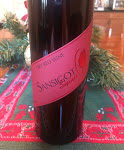 after WWII. The grape has a nice level of acidity, color, strength and tannin often with flavors of forest fruit and sweet spice. If you ever come across a bottle, please please give it a try! Our dinner guests highly rated it!
after WWII. The grape has a nice level of acidity, color, strength and tannin often with flavors of forest fruit and sweet spice. If you ever come across a bottle, please please give it a try! Our dinner guests highly rated it!
Teran Teh-rahn – Teran or Refošk (Slovenia) is a dark-skinned grape variety from the Refosco family that primarily grows in Western Istria in Croatia, in the Slovenian Primorska wine region, and northeastern Italy where it is known as Terrano. When grown in iron-rich terra rossa (Red Earth), Teran acquires a particularly distinctive flavor. Believe me, you will know the terra rossa when you taste the wine! Compared to Refosco, it ripens later with a more pronounced fruit and higher iron content. Teran makes dark, earthy, full-bodied robust reds. Expect bold flavors of wild berries, violets and twigs sometimes with smoky cured meat and gamey notes. It is usually high in tannins and should evolve over a few years. It has a distinct aroma sometimes described as smelling like blood or rust. Teran is highly acidic and depending on the winemaker, can be unpleasantly acidic. It is now also being used as a blending grape. It pairs very well with grilled or roasted big meats like the lamb shanks we prepared.
Wine regions of Croatia
Now that you know some basic info about the grapes, there are four primary wine-growing regions in Croatia. If you happen to be planning a vacation in Croatia like many people do nowadays, you may want to keep them in mind.
ISTRIA AND KVARNER
ISTRIA
Istria is in the northwest corner of Croatia, borders on Italy and is nicknamed “New Tuscany”. It leads the country in their wine-making quality revolution. Istrian wines are similar to those produced in Italy. The food and cuisine of this region most closely resemble Italy. Istria is known for seafood-friendly white wines made from Malvazija Istarska. Red wines are made from Teran. There is enormous potential for Croatian wine here.
KVARNER
Kvarner is located between Istria and mainland Croatia. It includes the islands and coast of the Kvarner Gulf. Most wine production is on the islands of Pag and Krk. The islands of Susak, Krk, Cres and Lošinj are home to the Sansigot/Sušćan indigenous variety. Wine produced in the islands and the Dalmatian coast is of a highly individual style due to the harsh nature of the vineyards and microclimates.
DALMATIA
Dalmatia is the southernmost Croatian wine region and is bordered to the west by the Adriatic Sea, the east by Bosnia and Herzegovina and the south by Montenegro. The climate is warm and sunny. Dalmatia can be divided basically into three areas: Northern Dalmatia, Central-South Dalmatia and the Dalmatian Hinterland. The cuisine and wine of Dalmatia is Mediterranean in style. It’s all about seafood, olive oil and fruit-forward high alcohol red wines here. Two white grapes to know are Pošip and Debit. Red varieties to know are Plavac Mali and Babić.
PELJEŠAC PENINSULA
The terrain is so steep here that ropes and pulleys are often used during harvest. Farmers used to need donkeys to take their grapes over the slopes to vinification. Now there is a tunnel! This is the home of Mike Grgich’s Croatian wines. He makes Grgić Pošip and Plavac Mali in his Grgić Vina Winery. Another newsworthy producer is Edivo who stores and ages his wines underwater in the Adriatic Sea.
MAINLAND DALMATIA
The mainland stretches from the city of Zadar to Montenegro on the south. There are many microclimates here which allows for many different wine styles. Konavle Valley is near the border of Montenegro and is one of the most prominent wine growing hills in Southern Dalmatia. Many people left the area in the 1990s due to war and many vineyards were burned. Many vineyards have now been replanted and Malvasija Dubrovačka thrives here. Konavle has a long tradition of making wine from Malvasija Dubrovačka.
HVAR ISLAND
Hvar Island is located off the coast of Dalmatia and has been planted with grapevines for 24 centuries. It was added to the UNESCO World Heritage List in 2008. It has the oldest certified Plavac Mali vineyard in the world.
CROATIAN UPLANDS
The Croatian Uplands are in the center of the country bordered to the north by Slovenia and Hungary and to the south by Bosnia and Herzegovina. The Uplands are nearest to Zagreb. Aromatic whites like Riesling, Pinot Gris and Chardonnay are produced here, and Pinot Noir is one of the key reds. The Uplands is often overlooked in the Croatian world of wine. It is cooler here with very low temperatures for the vines in winter and frost in late spring and early autumn. Once known for making cheap white wine, several winemakers are now trying to break that bad reputation.
SLAVONIA AND THE DANUBE
Slavonia and the Danube are located on the far eastern side of Croatia. Cuisine in this part of continental Croatia is more Hungarian or Slavic. Whites reign supreme here. Graševina and Traminac are the key white varieties. Graševina is also known as Welschriesling. This is a fabulous but often overlooked wine growing region.
SLAVONIA
Slavonia is located in the northeastern part of Croatia between the Danube, Sava and Drava Rivers. More than ¾ of Croatia’s Graševina comes from Slavonia, and it is not to be confused with Slovenia. Slavonia is also famous for its oak wine barrels.
THE DANUBE
The Danube is the easternmost wine region. It has a continental climate, flat plains and very fertile soil. This is also Graševina wine growing country.
“An Evening in Croatia” ……….The event!
Armed with my new found knowledge about Croatian wines gained from reading “Cracking Croatian Wine” and watching every video, Instagram or Facebook post by my friends at Exotic Wine Travel, I 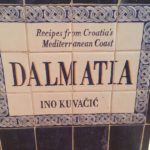 purchased a good representative selection from Blue Danube Wine Company. I was sure they were going to be spectacular!!!! Next up, what to serve with them? After reading about Croatian cuisine on the internet, I started to review cookbooks and decided on “Dalmatia” Recipes from Croatia’s Mediterranean Coast by Ino Kuvačić. (Note to anyone cooking any of these recipes: be prepared for garlic garlic garlic! It goes in everything – and lots of it. But no one complained.) As in all good plans, I needed a few more ideas and recipes that eventually came together and on paper, sounded like a marriage made in heaven for my wines!
purchased a good representative selection from Blue Danube Wine Company. I was sure they were going to be spectacular!!!! Next up, what to serve with them? After reading about Croatian cuisine on the internet, I started to review cookbooks and decided on “Dalmatia” Recipes from Croatia’s Mediterranean Coast by Ino Kuvačić. (Note to anyone cooking any of these recipes: be prepared for garlic garlic garlic! It goes in everything – and lots of it. But no one complained.) As in all good plans, I needed a few more ideas and recipes that eventually came together and on paper, sounded like a marriage made in heaven for my wines!
At long last after I had lovingly watched over the wines, and Chuck and I had our food prepared, our guests assembled. I am sure it was with great trepidation that they prepared to drink Croatian wines. As I already said, I just knew the wines would be excellent, but no one else in the group had reason to share my expectations. I am so happy to tell you that as each bottle of wine was emptied, everyone kept exclaiming how much they were enjoying these wines. In fact, the consensus of opinion was that we would be happy to drink each and every one of them again! So here are the courses of food as served and the exact wines that we paired with them on February 3, 2018.
An Evening in Croatia
Appetizers
Paski Sir Pag Island Cheese, Feta & Goat Cheese, Prosciutto,
Dalmatian Red Pepper Spread, Olives, Flatbread, Crusty Bread
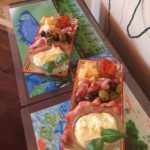 Pag is the third largest island in the Gulf of Kvarner and is very famous for its Paski sir Pag Island sheep milk cheese which is generally
Pag is the third largest island in the Gulf of Kvarner and is very famous for its Paski sir Pag Island sheep milk cheese which is generally 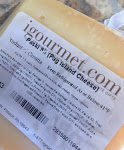 regarded as the most famous artisan cheese of Croatia. I found one piece of this cheese remaining on the Igourmet website and snatched it up! The feta and goat cheese was blended together with fresh herbs, lots of garlic and EVOO.
regarded as the most famous artisan cheese of Croatia. I found one piece of this cheese remaining on the Igourmet website and snatched it up! The feta and goat cheese was blended together with fresh herbs, lots of garlic and EVOO.
2015 Dubrovački Podrumi Malvasija Dubrovačka, Konavle
Dubrovačka Podrumi was devastated and burnt in the 1990s like the rest of the area, but some local entrepreneurs bought it in 2000, planted new vineyards and brought it back to life. The winery farms 30 hectares (owned by the State) of old vine Cabernet Sauvignon and Merlot. They buy Malvasija Dubrovačka from local grape growers and make a dry crisp white wine with herbal notes.
Salad
Lentil Apple and Pomegranate Salad on a bed of Mixed Greens
(Salata od leće jabuke i nara)
Lentils are eaten frequently in Croatia, in soups, stews and salads and they are very nutritious for you. I 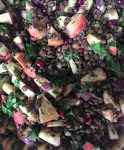 served a scoop of the lentil salad on a bed of baby mixed greens and added some additional red wine vinaigrette dressing. This made a colorful, memorable, tasty winning salad course. The Graševina was a perfect wine for it.
served a scoop of the lentil salad on a bed of baby mixed greens and added some additional red wine vinaigrette dressing. This made a colorful, memorable, tasty winning salad course. The Graševina was a perfect wine for it.
2015 Adžić Graševina, Graševina, Slavonia
Antun Adžić makes some of the best Graševina in Croatia. Adžić is a family winery established in 1995 in the Kutjevo region on the southern slopes of Kamdija. They make quality wine here using the same traditional methods of the last 800 years. Adžić built a modern wine cellar as part of the family house in order to make his quality wines. They have 8 hectares of their own and buy fruit from 2 more.
Soup
Carrot, Capsicum and Eggplant Soup
(Fuha od markve, balancana I crvene paprika)
This fresh vegetable soup could also be served chilled, 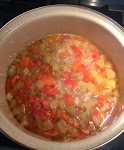 but I served it hot garnished with fresh herbs. Cook up those well-seasoned vegetables, don’t forget the garlic!, then puree it up right in the pan
but I served it hot garnished with fresh herbs. Cook up those well-seasoned vegetables, don’t forget the garlic!, then puree it up right in the pan 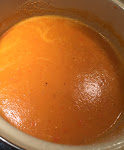 with your immersion blender. I could eat this soup every day, I loved it so much! Make it a day ahead to really develop the flavors. Besides items that can be cooked a day ahead is really helpful when preparing for a dinner party! Just heat it up in your crockpot and serve.
with your immersion blender. I could eat this soup every day, I loved it so much! Make it a day ahead to really develop the flavors. Besides items that can be cooked a day ahead is really helpful when preparing for a dinner party! Just heat it up in your crockpot and serve.
2015 Coronica Gran Malvasia, Malvazija Istarska, Istria
Coronica is a notable Istrian producer. Malvazija and Teran are the grapes to focus on here and Moreno Coronica is the man who makes them into great wines. He established Coronica in 1992 after the fall of Communist Yugoslavia. His Gran Malvazija is a premium bottling and it gets better with every vintage. Moreno’s Gran Teran is one of the best expressions of Teran. His goal is to make wine that reflects the region. This was my very favorite of the whites. Did you know that Riedel even makes a special glass for serving Istrian Malvasia? Much to my amazement, I did find them on-line after seeing pictures of Charine enjoying her Malvasia in one and recommending it. I love Riedel as much as the next winelover and have numerous cases of Riedel glasses of different sizes and shapes, but I just couldn’t bring myself to spend over $100 per glass. It’s called the “Superleggero Loire” because someone found out that it is also perfect for Sauvignon Blanc. Young Istrian Malvasias are often compared to Sauvignon as they are both fresh with fruity aromas of  apple and apricot. Really wanting to have the complete Malvasia experience, I did find some Italian Malvasia glasses from the “BB&B” store and got a few. Here is a picture of one. Did they make the wine taste any more enjoyable? I’m not really sure but I like the look of them and I gave myself an A+ for the experience!
apple and apricot. Really wanting to have the complete Malvasia experience, I did find some Italian Malvasia glasses from the “BB&B” store and got a few. Here is a picture of one. Did they make the wine taste any more enjoyable? I’m not really sure but I like the look of them and I gave myself an A+ for the experience!
Meat, Fish and Vegetables
Lamb Shanks with Tomatoes and Peas (Fanjetina s bižima)
The lamb shanks were to be seared and then cooked on low heat in a pan with the tomatoes, potatoes and peas. However, since Chuck had this giant pan filled with 8 very huge lamb shanks, we made the decision to cook the vegetables separately from the shanks. In hindsight, the shanks would probably have had that desired “just to fall off the bone but not quite” characteristic, but turned out more like grilled meat which really was perfect with the red wines. The veggies were absolutely delicious. Must have been all that garlic!
Croatian Sausages (Ćevapčići) with Eggplant Pepper Relish (Ajvar), Sour Cream, Lemon and Flatbread
Somewhere in my recipe research, I learned about “the sausages”. According to good old Wikipedia, “Ćevapi or ćevapčići is a grilled dish of minced meat, a type of skinless sausage, found traditionally in the countries of southeastern Europe (the Balkans). They are considered a national dish in Bosnia and Herzegovina and Serbia and are also common in Croatia, ……………” . I am not an experienced sausage maker but discovered a recipe used at Mike Grgich’s winery in Napa which I am happy to say I have visited and even seen Mike there, but never had “the sausage”. The recipe sounded simple especially since the sausages are skinless, and it was a hit. I think my guests would have been happy just to have a big platter of these little misshapen sausages which I served with the recommended accompaniments of Ajvar (Croatian eggplant and red pepper relish which I highly recommend), some sour cream, lemon wedges and flatbread. Just be sure to prep your sausages the day before you are going to cook and serve and don’t leave out the sparkling water. Here once again, I think it’s all in the garlic!
Shrimp in Garlic White Wine and Tomato
This is a popular dish throughout the Eastern Mediterranean area. Unfortunately I did not go in search of langoustine as called for in my recipe, but the shrimp were a great option for any non-meat eating guests.
Dalmatian Silverbeet (Swiss Chard) (Blitva na dalmatinski)
Swiss chard is a staple dish in Dalmatian. According to my cookbook author, other Croatians actually call Dalmatians “silverbeets” because they eat so much of it. I cooked it with sweet potatoes instead of white and it was a perfect green vegetable.
Croatian Sauerkraut
We had recently served sauerkraut as part of the Pfalz German food and wine pairings for the infamous Volcanic Wine Dinner, but this sauerkraut was unlike any other we have cooked and eaten. First I opted to buy fresh sauerkraut at our local Publix supermarket instead of making it in a barrel from cabbage for 40 days according to my cookbook recipe, although I had seen my parents doing that when I was a child in growing up in Pennsylvania. Ours was rinsed and slowly simmered with tomato sauce, chicken base and onions. Add some bacon at the end. It’s delicious.
2014 Coronica Crno, Red Blend, Istria
Crno means “red” in Croatian and this red was an excellent example of blending reds in Croatia. We had 80% Teran, 10% Merlot and 10% Cabernet Sauvignon in the bottle and we really liked it! The blend is dominated by the Teran and that Terra Rossa soil which gives it the characteristic briny iron note. This was our first red of the night, and it gave us a great introduction to the red wines of Croatia. Our guests were all happy winelovers!
2015 Šipun Sansigot, Otok Krk
Šipun, located on the island of Otok Krk, is one of only two producer of this rustic wine from Sansigot. Ivica Dobrinčić, Šipun’s owner and winemaker, helped to save this grape from extinction. Krk is the largest of Croatia’s 1000+ islands. Sansigot has also grown on the tiny island of Susak. Susak was once known as a “floating vineyard” due to the fact that 95% of the island’s area was covered with vineyards. Our friends at Exotic Wine Travel say the Šipun Sansigot is a “rustic and oddly compelling wine”.
2015 Bibich G6, Grenache, North Dalmatia
Debit white indigenous varietal in the wine region of Skradin. Bibić also likes Grenache and Shiraz and produces them in the Rhone style. He ferments these wines with native yeasts and ages them in French used oak for a year giving the wine French “garrigue” with a briny Croatian touch. Alen Bibic is a life-long native of this area and deserves a lot of the credit for putting Skradin back on the wine map. His mission today is to bring these wines to international prominence. He hopes to sustain the indigenous grapes like Debit but since he likes Rhone-style wines, I thought it would be interesting to try one made in Croatia. The wine was a most satisfactory 100% Grenache aged 12 months in used French oak filled with minerals and peppery Mediterranean herbs only with a briny Croatian touch. Olive trees grow among the grapevines here just like the Rhone.
2013 Miloš Plavac, Plavac Mali, Pelješac Peninsula
Frano Miloš (mee-loash) organically farms 100% Plavac Mali on coastal vineyards of steep 45 degree slopes covered with handmade stone terraces. His family has been making wine here for over 500 years. This winery allegedly produced the first Croatian cult wine but is now iconic with a differentiated distinct style. The Milos wine was rich and concentrated with very dark fruit, mineral and herbal notes. The longer we left this wine in the glass, the better it became. According to the tasting notes sage is the dominant herb with distinctive notes of black tea on the nose, and savory saltiness on the palate. Get out the grilled meat as our lamb shanks and Croatian sausages paired well with it. Milos ages it for 2 years in large used Slavonia oak barrels and it shows. We so enjoyed this almost 14% alcohol wine! And it’s organic.
2013 Coronica Gran Teran, Teran, Istria
Moreno Coronica’s Gran Teran is 100% Teran and made from vineyards just an hour south of Trieste, Italy. The rust colored “Terra Rossa” soil is very famous and gives the wines a very unique deep mineral taste. We decanted the wine for over an hour as recommended and were expecting something really big, tart and harsh but were quite surprised with a wine just 13% alcohol very well balanced by the winemaker. Another winner with lamb shanks!
Sweets
Palačinke (pa-la-cheen-keh)
Ricotta Pancakes with Strawberry Compote and Ice Cream
I love to make desserts and whether you call these pancakes or crepes, this dessert is very representative of dining in Croatia and not really difficult to make. I just use a regular small skillet to make my crepes and have fine-tuned that process to go very quickly. You can even make them in advance. Just be sure to put a piece of waxed or parchment paper between each one. I opted to go with the ricotta filling and fresh strawberry sauce instead of the many other options like walnut filling with chocolate sauce. Topped it off with a scoop of vanilla ice cream and you will have very happy guests!
Pear Brandy
According to my Croatian recipe book, a Croatian meal with guests is not complete without brandy and liqueurs, more specifically maraschino cherry brandy, pear brandy or plum brandy. I just happened to have a bottle of French pear brandy complete with a pear in the bottle, and it was most impressive! Between the pear brandy and an assortment of Ben Rye, Oremus, and Madeira remaining from our Volcanic Wine dinner, we were quite prepared to set a proper Croatian table.
Most Recipes from “Dalmatia” Recipes from Croatia’s Mediterranean Coast by Ino Kuvačić 2017
Wines from Blue Danube Wine Company, Los Altos, CA
Forkandcorkdivine.com 1/29/18
When dinner was over and the wine bottles were all emptied, our guests discussed which wines they preferred the most. We were amazed to find out that the Šipun Sansigot from the island of Krk was a major frontrunner. The Miloš Plavac was also a frontrunner with the Coronica Crno and Coronica Gran Teran right there with them. All of the whites were fresh, full of white fruits, and aromatic. The barrel aged Coronica Gran Malvasia had a wonderful nuttiness and texture imparting a smoky brininess called “Freškina” in Croatia. We are all anxious to enjoy this “scent of the sea” once again. The food was delicious and everything paired well together once again supporting the theory that “what grows together goes together”!
What did I learn from this adventure?
Learning about more obscure wines can be a very rewarding experience no matter what degree of wine knowledge you may have. It doesn’t even need to be “obscure”. It might just be a region you are not familiar with. There is so much more to learn than just the wine! With every new adventure, or research project as I like to call it, I learn about the wine region, history, the people, the culture, the cuisine and of course the wine. In addition to that, I usually make a number of new wine acquaintances along the way which makes life very exciting. Now my guests and I can say that Croatian wines are no longer obscure to us and I guarantee you, we would all love to drink them again…….and again! One of our guests asked me which was my favorite and I had to reply “They are all my children and I love them all equally! So what’s on the schedule for my future research? I do have a few topics in mind, so stay tuned. In the meantime, time is too short to not drink good wine. There are so many winemakers in this world now making great wine whether they may be on the tiny remote island of Krk off the coast of Croatia, or on the hill of Somlo, Hungary, or in world-famous Napa Valley, California. Please don’t be afraid to try something new even if you have to step outside your comfort zone. You just may find that you really like it! Cheers!
lfrakos@gmail.com 2.13.18

